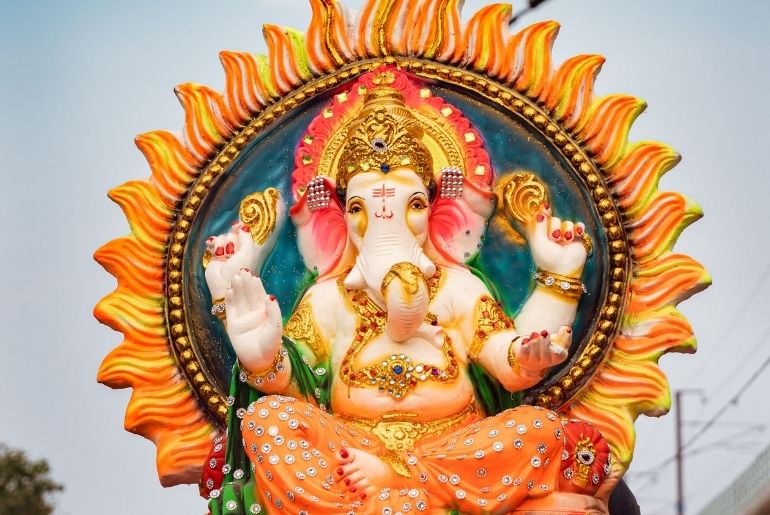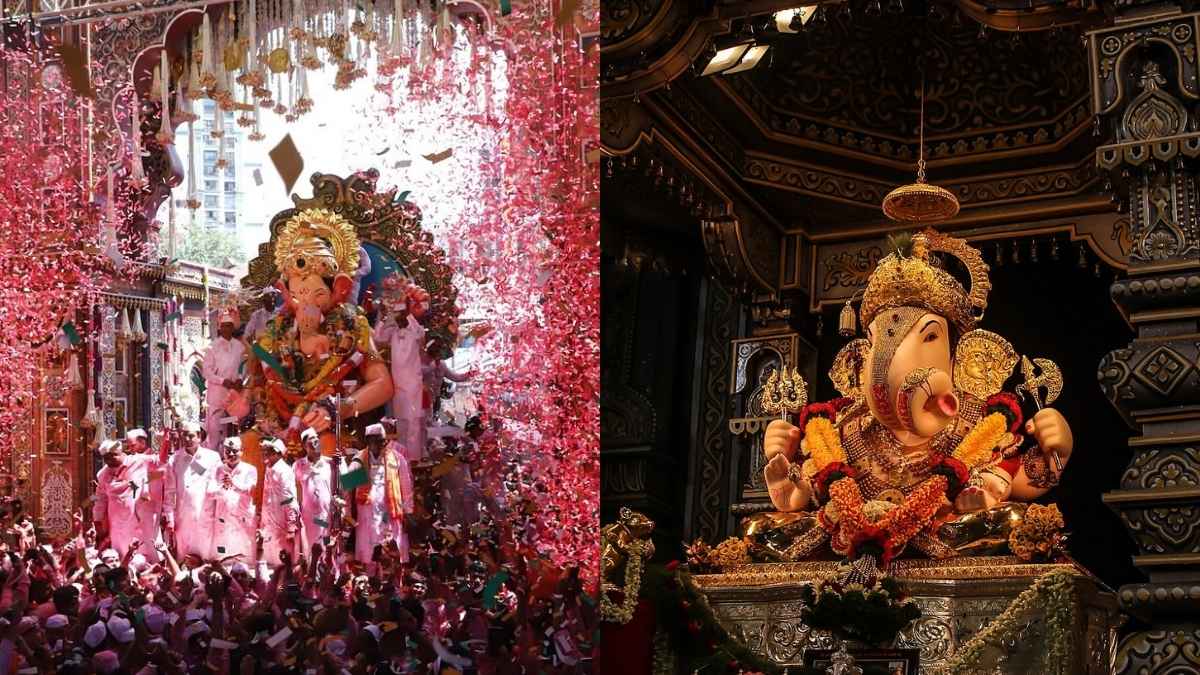Every year around these months, Maharashtra stops pretending to be business as usual. The monsoon hasn’t quite left, the air smells of wet earth and incense, and the streets are claimed by one deity: Lord Ganesha. For ten days, from his grand arrival to the emotional farewell, the state becomes a stage for devotion. But ask anyone where Ganeshotsav is the brightest and most festive, and two names come up immediately: Mumbai and Pune. The distance between them is barely three hours by road, but the experience feels like two entirely different dialects of the same language.
The Beating Heart Of Ganeshotsav: Mumbai

In Mumbai, Ganeshotsav isn’t contained but rather spills into every crevice of the city. Work calendars bend, shop shutters pull down early, and traffic of enthusiastic devotees reaches a maximum.
Pandals
The undisputed pandal here is Lalbaugcha Raja. People wait for 12, sometimes 16 hours in snaking queues just to brush their fingers against the idol’s feet. A few streets away, Ganesh Galli is absolutely iconic with sets that mimic temples or even international landmarks. Suburban Mumbai has its own treasures: Andhericha Raja and Khetwadicha Ganpati, each with loyal crowds who dance to the vibrant tunes of Ganpati Bappa.
Also Read: Head To These Famous Sweet Shops In Pune To Get Ganpati Bappa’s Favourite Modak
Commute
If you think you’ll “drop by” Lalbaugcha Raja after work, think again. On peak days, even reaching Parel station feels like drowning in the crowd. Cabs refuse to enter certain zones and buses crawl at a slow speed. Most people rely on the local trains, BEST buses, and Mumbai Metro since traffic moves at a snail’s pace near pandals. Many pandal routes are pedestrian-only, so devotees often walk long stretches, weaving through lanes lit with festive décor. Auto-rickshaws and cabs operate, but expect diversions and long waiting times.
Crowds
The pandal in Lalbaug alone can attract a million people in a day, with police forming human barricades to control flow. Security checks, frisking, and bag bans are standard. But within the madness lies the magic: when a dhol-tasha troupe picks up tempo and the entire lane erupts into chants of “Ganpati Bappa Morya,” you feel part of something much larger than yourself.
Also Read: 7 Interesting Facts About Ganesh Chaturthi You May Not Have Heard Of
Costs
Mumbai is expensive year-round, and Ganeshotsav pushes it further. A modest hotel in Dadar or Fort can jump to ₹5,000 a night if you book late. Ride-hailing apps surge fully, and even autorickshaws around pandal-heavy zones may refuse short rides. The silver lining is the food. Street vendors thrive during the season: ₹30 vada pav, ₹150 modaks by the dozen, and thalis in Girgaon khanavals keep you full.
What Mumbai Offers
Think of Mumbai’s Ganeshotsav as a blockbuster movie: noisy, crowded, unpredictable, and larger than life. You leave from here with your clothes smelling of incense and smoke, your ears ringing, and your heart oddly full.
Pune: The Cultural Soul Of Ganeshotsav

If Mumbai’s Ganeshotsav is a stadium concert, Pune’s is a classical recital! It is no less powerful, but just more rooted. This is where Lokmanya Tilak transformed Ganesh worship into a public movement in 1893, and the city has never forgotten this fact!
Pandals
Pune’s pride lies in its “Manache Ganpati” or the five most honoured mandals. At the head is Kasba Ganpati, considered the city’s presiding deity. Close behind, Tambdi Jogeshwari and Guruji Talim carry their own deep legacies. Tulshibaug Ganpati, with its 15-foot idol, towers both physically and symbolically, while Kesariwada Ganpati is tied directly to Tilak’s home.
But ask locals where the crowds are, and they’ll point you to Dagdusheth Halwai Ganpati. With its gold-clad idol and year-round darshan, Dagdusheth is a magnet for celebrities, politicians, and travellers. During Ganeshotsav, it becomes the centrepiece of Pune’s cultural calendar, with bhajans, plays, and processions weaving through the night.
Commute
Unlike Mumbai, Pune is mercifully compact. Most major pandals are clustered in the old Peth areas, Shaniwar, Budhwar and Narayan, which means you can cover multiple stops on foot. The newly functional Pune Metro helps bridge outer suburbs to the core, and buses are plentiful, though traffic diversions still test patience near Swargate and Shivajinagar.
Also Read: And It Begins! Lalbaugcha Raja’s Muhurat Puja Kicks Off Ganeshotsav 2025 In Full Glory
Crowd
Compared to Mumbai’s human tidal waves, Pune’s crowds feel more manageable. Evenings around Dagdusheth can pack thousands into narrow lanes, but queues move briskly and police are more visible.
Cost
Hotels in the heart of the city- Deccan, Shivajinagar average ₹2,500–3,500 a night during the festival. Daily expenses hover around ₹5,000 for a mid-range traveller. Food is both affordable and glorious: misal pav in Sadashiv Peth, poha and chai at old Irani cafés, and modaks that sell out by dusk. Compared to Mumbai, you’ll cover more ground at half the price.
What Pune Offers
Pune’s Ganeshotsav is devotion offered with discipline. The processions still throb with dhol-tasha beats, but the overall pace lets you breathe, notice the craft of the idols, and actually talk to locals about history and culture.
So, who wins for you in the Ganeshotsav battle, Mumbai or Pune? If you’re a first-timer chasing adrenaline, Mumbai will blow your senses wide open. It’s loud and celebratory and you’ll walk away with goosebumps and stories you’ll tell forever. If you’d rather experience the same devotion in a way that lets you appreciate history, craftsmanship, and community spirit without battling a million-strong crowd, Pune wins hands down. Either way, Ganeshotsav in Maharashtra will leave you chanting “Ganpati Bappa Morya!” long after the drums go silent.
Cover Image Courtesy: lalbaugcharaja/Instagram and dave.kaustubh/Wikipedia
For more such snackable content, interesting discoveries and the latest updates on food, travel and experiences in your city, download the Curly Tales App. Download HERE. First Published: August 19, 2025 8:05 PM




